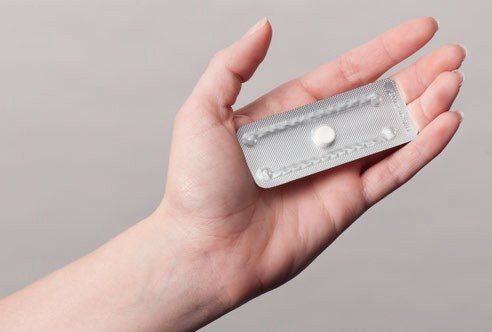This is an automatically translated article.
Ulipristal Acetate is a drug with specific antiprogesterone effects. This active ingredient is present in the product with the trade name Esmya. So what effect does Esmya drug and in what cases is it indicated?1. What is the effect of Esmya?
What does Esmya drug do? Esmya is a product of HRA Pharma, the main ingredient is the active ingredient Ulipristal acetate 5mg. Ulipristal acetate is a synthetic drug capable of modulating the progesterone receptor due to its local tissue-specific antiprogesterone effect.
Esmya drug acts directly on the endometrium, thereby causing endometrial changes related to Progesterone receptor modulator (PAEC for short). It should be noted, however, that Esmya-induced changes should not be confused with endometrial hyperplasia.
2. Indications and contraindications of Esmya
Esmya is indicated for the treatment of uterine fibroids in the following cases:
Use a course of Esmya for preoperative treatment of moderate to severe symptoms of uterine fibroids in patients of reproductive age; Sequential treatment of moderate to severe symptoms of uterine fibroids in patients of reproductive age who are not suitable for surgical treatment. Esmya is contraindicated in the following cases:
Hypersensitivity to Ulipristal Acetate or any ingredient contained in Esmya; Contraindications to the use of Esmya in pregnant or lactating women; Vaginal bleeding of unknown cause or due to conditions other than uterine fibroids; Breast, uterine, cervical or ovarian cancer; Patient has underlying liver dysfunction.
3. Dosage of Esmya
Esmya is only indicated for treatment and monitoring by a specialist with experience in the diagnosis and treatment of uterine fibroids.
Dosage of Esmya drug is recommended as follows:
Every day take 1 tablet of Esmya 5mg, each course of therapy lasts 3 months; Patients should start their first course of fibroids with Esmya on the first week of their menstrual cycle; Subsequent courses of treatment should begin as early as the first week of the next menstrual cycle after the end of the previous course; The physician should explain to the patient about the interval between treatment with Esmya ; Repeated serial therapy with Esmya has been studied and tested for up to 4 consecutive courses. Dosage of Esmya for special groups:
Patients with renal impairment: No dose adjustment of Esmya is required if renal impairment is mild to moderate. However, due to the lack of specific studies, Esmya is not recommended for use in severe renal impairment, if the patient is not closely monitored; Children: The use of Esmya is not relevant as the drug has only been studied in women 18 years of age and older. How to take Esmya:
Patient takes Esmya with water; Esmya can be taken before or after meals.
4. Side effects of Esmya
During the use of Esmya, patients may experience some of the following side effects:
Endometrial thickening:
About 10-15% of patients experience endometrial thickening over 16mm (determined) by ultrasound or magnetic resonance imaging) at the end of the first Esmya treatment. In subsequent courses of treatment, the frequency of endometrial thickening will be less; Endometrial thickness will return to normal after stopping Esmya treatment; In addition, this adverse effect of Esmya is related to progesterone receptor modulators and is completely different from endometrial hyperplasia.
Hot flashes: This side effect of Esmya was reported in approximately 8.1% of patients receiving the drug (incidence varied between trials). Hypersensitivity reactions with manifestations such as generalized edema, skin pruritus, skin rash, facial swelling or urticaria were reported in 0.4% of patients receiving Esmya in phase III studies. Headache: Mild to moderate headache adverse events have been reported in 5.8% of Esmya-treated patients. Ovarian Cysts: This side effect of Esmya may occur during and after treatment in about 1.0% of patients and resolves spontaneously in the majority of cases. Uterine bleeding: Severe cases of heavy menstrual bleeding due to uterine fibroids, if associated with this side effect of Esmya, sometimes require surgical intervention.
5. Esmya Drug Interactions
Esmya has a steroid structure and acts as a selective regulator of the Progesterone receptor. Concomitant use of progestogen-containing contraceptives may reduce the effectiveness of Esmya by competing with the progesterone receptor. Therefore, Esmya should not be used concurrently with drugs containing Progestogen.
Inhibitors of the enzyme CYP3A4 may increase the peak concentration and AUC of Esmya. Therefore, the concomitant use of Esmya with moderate to strong inhibitors of the CYP3A4 enzyme is not recommended.
Inducers of CYP3A4 enzymes can significantly reduce peak concentrations and AUC of Ulipristal acetate when used concomitantly. Therefore, it is not recommended to co-administer Esmya with strong inducers of CYP3A4 (eg, Rifampicin, Rifabutin, Carbamazepine, Oxcarbazepine, Phenytoin, Fosphenytoin, Phenobarbital, Primidon, Efavirenz, Nevirapine, Ritonavir).
Ulipristal acetate may decrease the effectiveness of hormonal contraceptives (such as Progestogen-only Pills, Progesterone-releasing IUDs or combined oral contraceptives) and other medicines containing Progestogen. Therefore, progestogen-containing drugs should not be used concurrently with or within 12 days of discontinuation of Esmya.
In vitro data indicate that Ulipristal acetate can inhibit P-gp during absorption. However, the co-administration of Esmya with a P-gp substrate has not been studied, so the possibility of an interaction cannot be excluded. In vivo results showed that Esmya 10 mg administered approximately 1.5 hours before Fexofenadine 60 mg (a P-gp substrate) did not affect the pharmacokinetics of Fexofenadine. Therefore, patients who are required to take the two groups of drugs at the same time, it is best to take Esmya at least 1.5 hours from the time of using the substrates of P-gp.
6. Some notes when using Esmya
Some notes when using Esmya drug are as follows:
Esmya drug is only prescribed by a specialist doctor after a diagnosis of uterine fibroids has been confirmed, and the patient should be excluded the possibility of pregnancy before using it. drug use. Although the majority of patients will not ovulate with a single dose of Esmya, it is still recommended that an additional non-hormonal method of contraception be used during treatment (as Esmya may interact with oral contraceptives containing the drug). Progestogen or combined oral contraceptives.) As mentioned above, Esmya may thicken the endometrium but is reversible upon discontinuation of treatment. Therefore, patients with an indication for repeated serial therapy of Esmya should have their endometrium periodically monitored with annual ultrasound when menstruation resumes during the discontinuation period. If the endometrium persists after the return of menstruation during the discontinuation period or 3 months after the end of treatment and/or there is a change in the menstrual cycle, the patient should be examined (by birth). endometrial biopsy) to rule out potential causes, including endometrial malignancy. It is recommended that each course of Esmya treatment should not exceed 3 months because the risk of adverse effects on the endometrium has not been determined with prolonged use. Physicians should instruct patients that the use of Esmya usually results in significant reductions in menstrual bleeding or amenorrhea within the first 10 days of treatment. On the contrary, if heavy bleeding still occurs, the patient should notify the doctor. Usually, your period will return within 4 weeks of finishing treatment with Esmya. Impaired renal function is unlikely to significantly alter the elimination of Ulipristal acetate. However, due to the lack of specific studies, Esmya is not recommended for patients with severe renal impairment without close supervision. In the post-marketing history of Esmya, there have been reports of liver damage and liver failure due to the drug. Therefore, patients should have liver function tests before starting treatment with Esmya, if transaminase enzymes (ALT and AST) exceed 2 times the upper limit of normal, then Esmya should not be used. At the same time, during the course of treatment, patients should have their liver function checked monthly during the first 2 courses of Esmya treatment. Subsequent courses of treatment only need to check liver function once before starting and when clinically indicated. If the patient has increased ALT or AST above 3 times the upper limit of normal during Esmya, the drug should be discontinued and closely monitored. Esmya is not recommended for women with severe asthma not adequately controlled with oral glucocorticoids. Esmya is a product of HRA Pharma, the main ingredient is the active ingredient Ulipristal acetate 5mg. Esmya is indicated for the treatment of uterine fibroids in certain cases. To ensure the effectiveness of treatment and avoid unwanted side effects, patients need to strictly follow the instructions of the doctor, professional pharmacist.
Follow Vinmec International General Hospital website to get more health, nutrition and beauty information to protect the health of yourself and your loved ones in your family.
Please dial HOTLINE for more information or register for an appointment HERE. Download MyVinmec app to make appointments faster and to manage your bookings easily.













